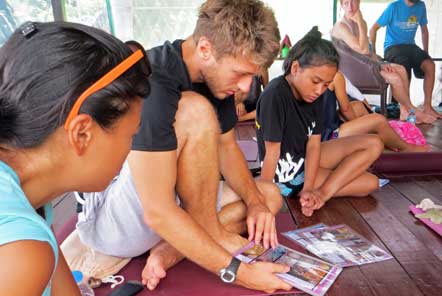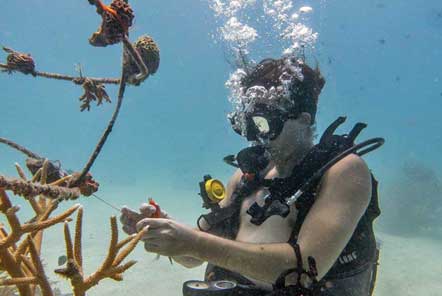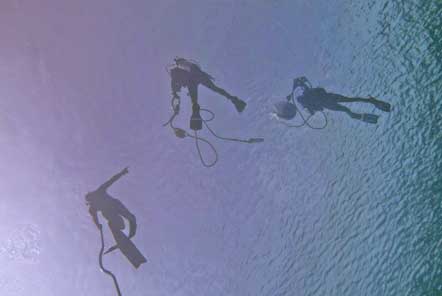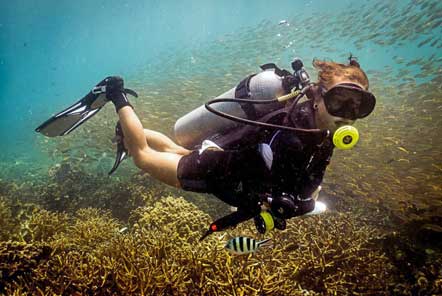A day in life of a Marine Conservation volunteer

We spoke to volunteer Cheyanne at our Marine Conservation project in Thailand to find out about a typical day on the island:
Daily life as a volunteer for the Marine Conservation project in Thailand is exciting, demanding, and fulfilling work. Each day begins with an educational lecture, followed by an always productive project, either on land or (most typically) underwater.

There is a vast array of lectures, including ecological monitoring surveying, coral nurseries and artificial reefs, giant clam nurseries, sea horses, nudibranchs, coral taxonomy and disease, sea turtles, sharks, and mooring line use and repair. Each lecture explains the ecological, economic, and social significance of the topic. We also learn about the practical ways the project facilitates change when issues pertaining to coral reefs arise in the local community and surrounding ecosystem.
In the artificial reef lecture we discover the reasons artificial reefs are used, how they are created and deployed, and how we stock and maintain them. Artificial reefs are used for a couple reasons. First, it gives corals a second chance. Sometimes corals are broken into pieces by things like wave action, predation, and human interference. By securing these fragments to artificial reefs, they are lifted from the suffocating sand and given a chance to regrow and continue thriving.

Second, artificial reefs support natural reefs by taking some pressure off them. Major stressors for natural reefs are caused by human touch and interference. With so many tourists visiting the reefs of Koh Tao, it can become harmful to the corals. Luckily, artificial reefs provide a new type of dive site for tourists to enjoy. Not only are artificial reefs rich with life, but they are also works of art. Many of the artificial reefs we deploy are intricate sculptures of metal or cement that portray sea life such as octopus, sea turtles, and sea horses. Others include mesmerizing underwater waves and even the faces of conservationists past and present. By divers choosing to visit these sites rather than the natural reef, the natural reef can be freed from some of its damaging stressors.
Artificial reefs are built by students, interns, and staff. Students and interns focus on simplistic shapes such as cones, spirals, and waves. Experienced and artistic staff create the more complex and intricate structures. We build the artificial structures by measuring, cutting, and bending metal rods. We then build the skeleton, placing each metal rod in place to create the desired shape. Finally, the rods are welded together — quite an exciting experience! Once built, artificial reefs are then deployed. This may entail bringing the structure onto the boat, or utilizing the barge for larger structures. Structures are sent to depth either by free diving for shallower sites, or utilizing lift bags while on SCUBA for deeper sites.

Once the artificial reefs are deployed, the true fun begins. We first visit the natural reef and collect fragments of coral, carefully choosing desired species. Then we head back to the artificial reef and attach the corals to the structure. This is done through a variety of methods, one being hitching. Hitching uses an oversized needle and thread to secure the fragment. We work carefully, being sure to avoid covering any living tissue with the thread. Some artificial reefs are what we call Coral Aid, which sends electrical current through the metal rods, helping to accrete calcium carbonate, the necessary compound for coral growth. This allows corals to grow as quickly and successfully as possible. We attach corals to Coral Aid utilizing thin metal wire, being certain that the metal wire touches the metal rod, which ensures an electric current is reaching the coral, allowing them to thrive. But while this type of diving is clearly different than your typical fun dive, it is not all just hard work.
On each dive, while we work diligently, there is plenty of beautiful life to enjoy. Take the large resident Map pufferfish of our Auw Luk dive site, for example. This massive beauty can regularly be seen relaxing or munching on a spongey meal at the artificial reefs. Red breasted wrasse poke around us as we work, showing off their curious nature. Schools of mullets pass by, and juvenile damselfish inhabit the Pocillopora corals amongst the reef. Finally, before the end of the dive, I always take time to look around and appreciate the extensive artificial reef success around me. All the corals in the vicinity were corals left for dead in the sand, but given a second chance at life. Many artificial sites are so filled with life it is nearly impossible to tell that there is a metal structure beneath. This level of growth can be reached in a matter of just a few years, and it is truly inspiring to see the success of the artificial reef efforts.

A day in the life as a volunteer is filled with fun, beauty, hard work, and a sense of fulfilment. There is nothing more inspiring than seeing the positive change your own two hands can make.”
If you would like to find out more about the project and how you could join the team in Thailand you can visit our project page for more details.







